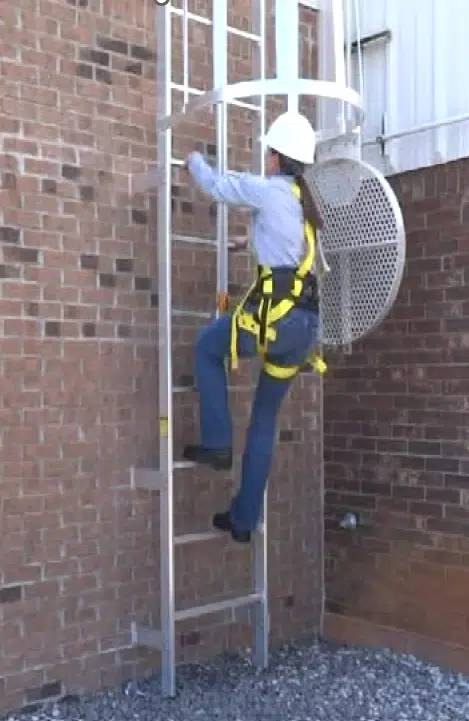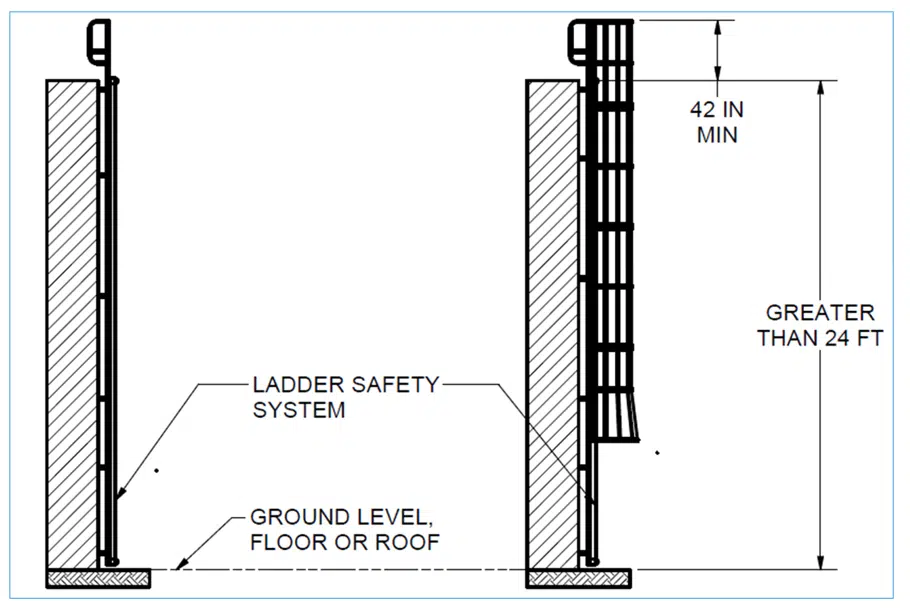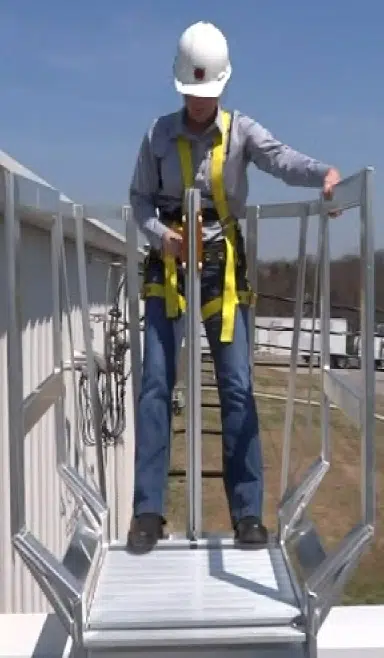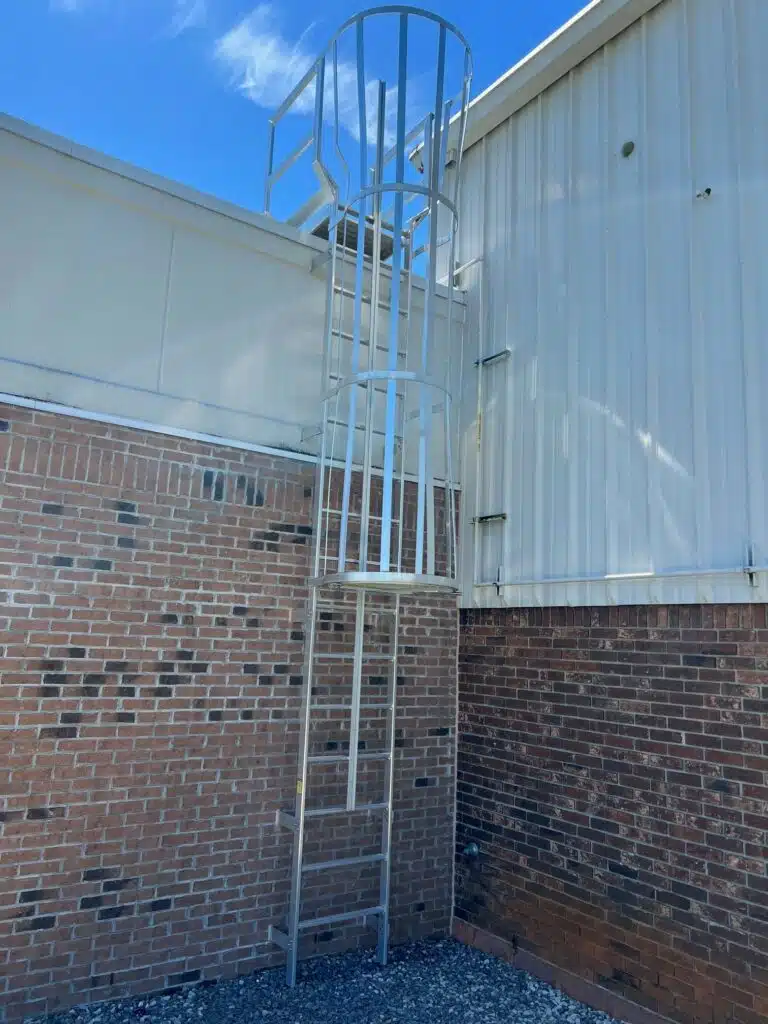Fixed Ladders Over 24 Feet
With the New Rule for Walking-Working Surfaces that OSHA published in November 2016, they announced they were phasing out cages as fall protection.
According to OSHA, after 2036 cages will not be considered as fall protection. Cages are not prohibited but if used must be used in combination with a Ladder Safety System or Personal Fall Protection System on ladders over 24 feet.
OSHA 1910.28(b)(9)(i)
- For fixed ladders that extend more than 24 feet (7.3 m) above a lower level, the employer must ensure:
OSHA 1910.28(b)(9)(i)(A)
- Existing fixed ladders. Each fixed ladder installed before November 19, 2018 is equipped with a personal fall arrest system, ladder safety system, cage, or well;
OSHA 1910.28(b)(9)(i)(B)
- New fixed ladders. Each fixed ladder installed on and after November 19, 2018, is equipped with a personal fall arrest system or a ladder safety system;
OSHA 1910.28(b)(9)(i)(C)
- Replacement. When a fixed ladder, cage, or well, or any portion of a section thereof, is replaced, a personal fall arrest system or ladder safety system is installed in at least that section of the fixed ladder, cage, or well where the replacement is located; and
OSHA 1910.28(b)(9)(i)(D)
- Final deadline. On and after November 18, 2036, all fixed ladders are equipped with a personal fall arrest system or a ladder safety system.
Ladder Safety System and Personal Fall Arrest System
OSHA Definitions:
Fall protection means any equipment, device, or system that prevents an employee from falling from an elevation or mitigates the effect of such a fall.
Ladder safety system means a system designed to eliminate or reduce the possibility of falling from a ladder. A ladder safety system usually consists of a carrier, safety sleeve, lanyard, connectors, and body harness. Cages and wells are not ladder safety systems.
Personal fall protection system means a system (including all components) an employer uses to provide protection from falling or to safely arrest an employee’s fall if one occurs. Examples of personal fall protection systems include personal fall arrest systems, positioning systems, and travel restraint systems.
A Ladder Safety System and a Personal Fall Arrest System are very similar. With each system the user wears a harness that connects to the trolley which ascends with the climber as they climb. There are rigid rail and cable systems available.

OSHA code requires fall protection on ladders over 24 feet. Cages are not required and are no longer considered fall protection, but some people are choosing to do both a Ladder Safety System and a cage on Fixed Ladders over 24 feet.

Cages are recommended on shorter ladders in dangerous locations. For example, if there were chemicals or machinery that the climber could fall into below.
If a cage is used, the cage is to extend a minimum of forty-two inches above the top landing. The cage shall start no less than seven feet and no more than eight feet above the ground. Cages size and shape are set by code.
For a walk-thru fixed ladder without a personal fall arrest system the maximum distance between the side rails is 30-inches at the exit but if there is a fall arrest system on the ladder the maximum distance between the side rails at exit can go up to 36-inches to allow for space for the climber to get around the fall arrest system.

OSHA 1910.23(d)(5)
- For through ladders, the steps or rungs are omitted from the extensions, and the side rails are flared to provide not less than 24 inches (61cm) and not more than 30 inches (76 cm) of clearance. When a ladder safety system is provided, the maximum clearance between side rails of the extension must not exceed 36 inches (91 cm);
ANSI states that the cage shall be provided on ladders with climb of more than twenty-four feet, or if the elevation reached is 24 feet. ANSI also states that cages start 7’-8’ above the ground and the cage size and shape are set by code.
ANSI A14.3 4.1.4.2
- Ladder safety systems shall be used when the length of climb of a ladder or multiple section ladders exceeds 24 feet in a single length of climb and rest platforms shall be provided at maximum intervals of 150 feet.
If your next project requires a Fixed Ladder over 24 feet contact Precision Ladders.
We know you want an easy access solution for your project. It takes time and effort to research, find, and know the code requirements. The different codes can cause you to feel frustrated, confused, and leave you second-guessing your work. At Precision, we give companies, workers, and their families peace of mind by providing code compliant Aluminum Ladders and Stairways creating safe access to any building space.


